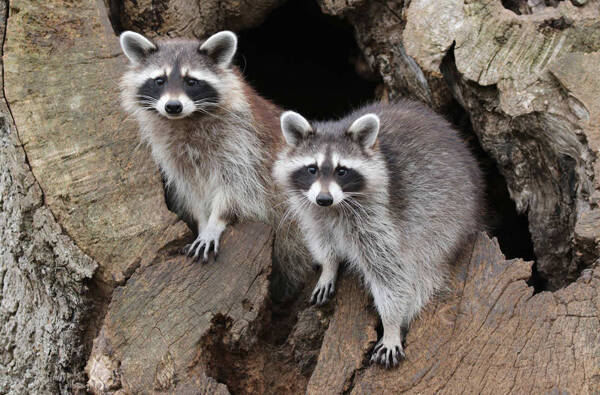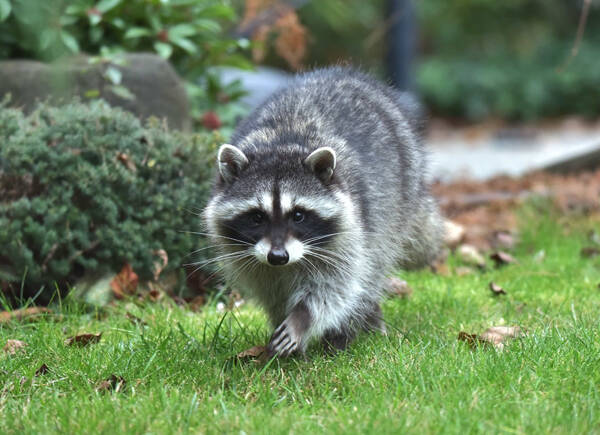Procyon lotor
IUCN
LCBasic Information
Scientific classification
- name:Procyon lotor
- Scientific Name:Procyon lotor,Northern Raccoon,Food thief, Pippi Bear, Raccoon
- Outline:Carnivora
- Family:Procyonidae Procyoninae Procyon
Vital signs
- length:40-65cm
- Weight:4-10kg
- lifetime:5-16years
Feature
He has black eye spots on his face and a funny appearance, so he is nicknamed "The Masked Bandit"
Distribution and Habitat
Present: Belize, Canada, Costa Rica, El Salvador, Guatemala, Honduras, Mexico, Nicaragua, Panama, United States.
Introduced: Austria, Azerbaijan, Belgium, Czech Republic, Estonia, France, United States (Georgia), Germany, Hungary, Italy, Japan, Lithuania, Luxembourg, Netherlands, Romania, Russian Federation, Serbia, Slovakia, Slovenia, Spain, Switzerland, Ukraine, Uzbekistan.
Origin uncertain: Bahamas.
North American raccoons are highly adaptable and can be found in a variety of habitats and easily live near humans. They require ready access to water. Prefer to live in moist woodlands. However, they can also be found in farmland, suburban areas, and urban areas. Can live in a variety of habitats from warm tropical areas to cold grasslands.
Appearance
The North American raccoon is a medium-sized carnivore. The adult body length is 40-65 cm, the tail length is 20-40 cm, and the weight is 4-10 kg. The male is slightly larger than the female. The fur is dense, and the whole body fur is a mixture of gray and brown. Albino species can also be seen. There are black eye spots on the face, and the image is funny. The nickname is "Masked Thief". There are many black and white rings on the tail, about 5 to 7 rings. The claws cannot be retracted and are not sharp. The hands are very flexible and can catch flying insects.
Details
The North American raccoon (scientific name: Procyon lotor) is called Northern Raccoon in foreign language. It is a medium-sized carnivorous animal with 23 subspecies.

The North American raccoon is active at night and rarely active during the day. During extremely cold and snowy times, raccoons have been observed to sleep for extended periods of time, but not hibernation. During this time, their metabolic rate and temperature remain constant, and they live off their fat reserves, potentially losing up to 50% of their body weight. Raccoons are primarily solitary animals, with only females and cubs forming groups. Sometimes, males may stay with females for a month until their cubs are born. Their gait is generally walking, however, they are able to reach the ground at speeds of up to 15 miles per hour. They are very agile when climbing, and are not bothered by falls of 10-12 meters. Raccoons are not only excellent climbers, but also strong swimmers, although they may be reluctant to do so. Without waterproof fur, swimming would force them to carry extra weight. Raccoons do not travel far. They travel only to find food. In a cave in Virginia, USA, resident raccoons traveled between 0.75 and 2.5 km per night, with males traveling slightly further in the fall, winter, and spring, and cubs and females traveling longer in the summer.
Raccoon population density varies greatly with habitat type. In wetland, lowland areas such as swamps, intertidal areas, and floodplains, the density averages 50 per square kilometer; in agricultural areas and hardwood forests, the density is as high as 20 per square kilometer; in suburban areas, the density is as high as 69 per square kilometer. The highest density recorded was 400 per square kilometer in a Missouri swamp. Rabies may significantly affect population density, which can double during periods of low rabies incidence.
Raccoons have a highly developed sense of touch. Their human-like front paws are particularly sensitive, allowing them to easily manipulate and pry prey and climb. Raccoons usually pick up food with their front paws before putting it into their mouths. With their good hearing, raccoons are also extremely alert. Likewise, raccoons have excellent night vision.
They are omnivorous and can eat most of the prey they catch. Food is mostly from the ground or the ground near water. In North America, they eat berries, nuts, woodpecker eggs, reptile eggs, insects, turtles, frogs, small mammals, fish and clams, depending on the season. They always wash their food in water before eating. If they find bird eggs, they can skillfully dig holes in the eggs with their claws and then suck the juice from the eggs. When eating, they can cleverly grab food with their two front feet and eat it. Their front jaws have sharp canine teeth for biting and tearing food, and then they use their jaw teeth to grind and polish the food.

North American raccoons like to build nests on tree trunks or branches, with a diameter of at least 60 cm and at least 30 cm above the ground. Some also choose ground nests, most of which are abandoned groundhog nests, which can provide more heat regulation than tree holes. Females use tree holes as dens more than males, probably as shelter from predators and bad weather, especially when raising cubs.
Raccoons escape many predators by remaining inactive in their dens during the day. When they are active, they are alert and can become aggressive. They are preyed on by large predators such as coyotes, wolves, hawks, and owls. Their cubs may also be captured by snakes.
Females reach sexual maturity at 1 year old, males later. They are in estrus from January to March each year, with the peak in February. Females tend to estrus synchronously. Estrus breeding occurs during the day, and females are restless and move back and forth during estrus. Males can be seen chasing, mounting, and screaming. The gestation period is 63-65 days. One litter is born each year, usually 2-5 cubs. In the wild, life span can reach 5 years; in captivity, it can reach 16 years. The mother bear digs a den 1-2 days before giving birth; 1 day before giving birth, she curls up in the den and does not eat. The cubs are usually born in April, with their eyes closed at birth. They drink exclusively from their mother's milk for 9 weeks after birth and are not fully weaned until 16 weeks of age. The mother bear feeds her cubs alone.
Raccoons can be a nuisance to farmers. They can damage orchards, vineyards, melon fields, corn fields, peanut fields, and chicken farms. Their habit of moving to the next ear of corn before completing the first ear makes them particularly harmful to both sweet corn and field corn. Raccoons also carry plague, rabies, and other diseases and parasites that can be transmitted to humans and livestock. Raccoon fur has been harvested since colonial times. In the 1920s, "raccoon" coats were all the rage, with fur worth about $14 made. Although demand is no longer as high, the fur may still be sold as imitation mink, otter or seal fur. North American raccoons are also eaten in some areas.
Listed in the "IUCN Red List of Threatened Species" (IUCN 2015 ver 3.1) - Least Concern (LC).
Protect wildlife and eliminate game.
Maintaining ecological balance is everyone's responsibility!








